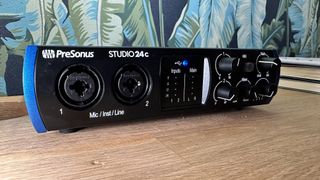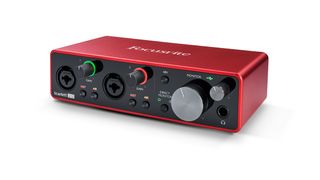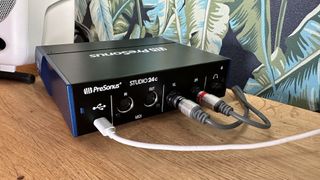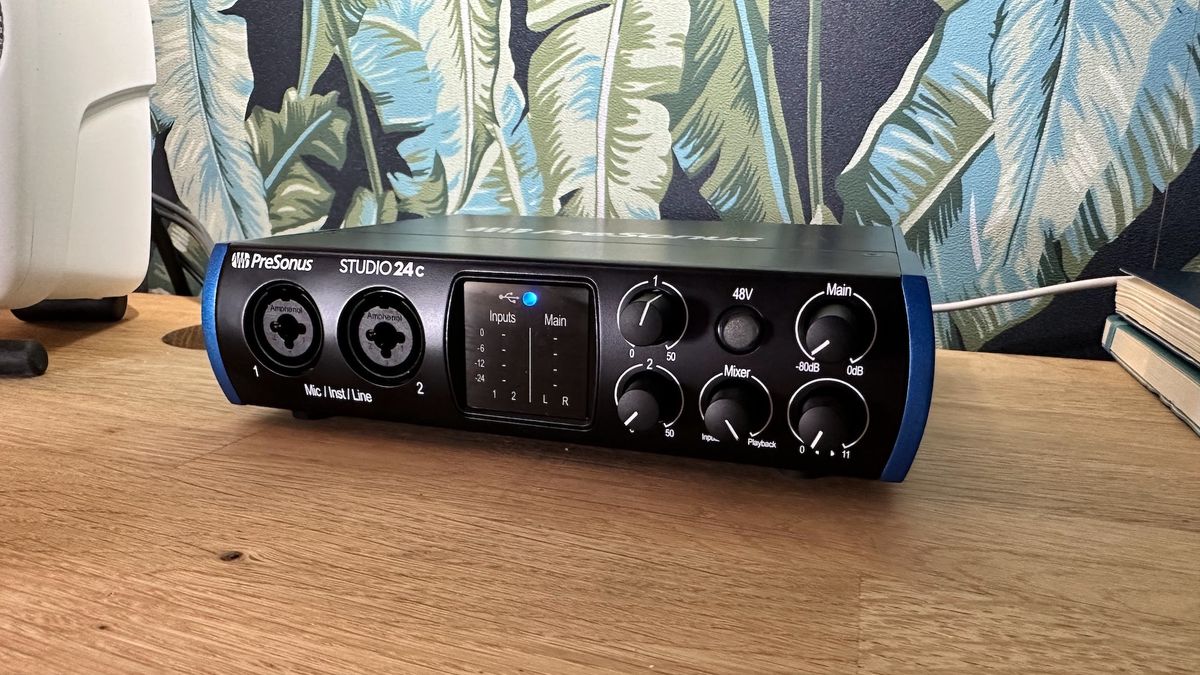MusicRadar Verdict
The PreSonus Studio 24c has everything the hobby studio could need, from high-quality audio to full MIDI I/O. For the price, it’s hard to beat.
Pros
- +
Superb, clean sound
- +
Loopback adds genuine utility
- +
MIDI connectivity increases its usefulness
Cons
- -
The controls are quite close together
- -
I prefer a front-facing headphone jack
MusicRadar's got your back
PreSonus Studio 24c review: What is it?
In a world where any laptop, computer or tablet can be repurposed into a fully-fledged music or audio recording studio, the humble audio interface has become one of the most important tools in a producer’s arsenal. Everyone from musicians to podcasters, via streamers and vloggers, all lean on their interfaces as a way of getting high-quality audio in, and out, of their devices. There is, however, a huge amount of choice so it can be difficult to know what good looks like, particularly at the budget end of the scale, with the majority of USB interfaces appearing to do largely the same thing, with the same set of features.
Enter the PreSonus Studio 24c. For a shade under $/£100, PreSonus is offering a highly usable, well-appointed budget interface with claims of high-definition audio and some neat tools for streamers under the hood. You get two inputs, which can handle XLR, instrument or line-level inputs and feature independent gain controls to ensure a clean signal reaches your software. You get two main outputs for studio monitors, for mixing and mastering your tracks, along with a dedicated headphone output. And, with the accompanying software, you can unlock some pretty interesting internal routing options via a feature called Loopback, which allows you to route audio between different applications. Ideal for game streamers, or podcasters (check out more of the best audio interfaces for streaming).
Competition is however fierce at the budget end. How does the PreSonus Studio 24c stack up? Let’s find out.
PreSonus Studio 24c review: Performance & verdict

The PreSonus Studio 24c forms part of a broader line of audio interfaces, with an input/output combination available to suit any user. The 24c we’re looking at today has established itself as one of the more popular interfaces in its price bracket, with many users seeing it as a nice alternative to the more ubiquitous Focusrite Scarlett range. On paper, however, there’s a lot going in favour of the PreSonus, even when compared to the new Scarlett 2i2 4th-gen line-up.

Focusrite Scarlett 2i2
IK Multimedia AXE I/O ONE
Universal Audio Volt 2
For starters, the Studio 24c has MIDI in/out connection points which is an absolute godsend for anyone using external keyboards, sequencers, samplers or synths. This allows you to programme music into your DAW of choice, and then have it control all manner of external gear, or vice versa. So, as the hub of a broader studio environment, where the laptop plays a role rather than being the be-all and end-all, the PreSonus is a wiser choice than the equivalent Focusrite.
Sound-wise, the Studio 24c displays its strengths immediately, both in the sounds themselves and what you can do with them. Two high-quality PreSonus mic preamps mean vocals and speech applications come through with plenty of clean headroom, perfect for editing inside your software. Additionally, two high-headroom instrument preamps allow you to play and record guitars, basses, synths and more. Input monitoring on the front of the unit is clear and easy to understand thanks to bright LEDs, while direct monitoring means you can record without lag or latency. On the software side, PreSonus bundles in Universal Control, which is where you access the Loopback feature. This means you can route audio from one app, i.e. a game, into your preferred streaming platform quickly and simply.

Other details are a bit more subjective. The headphone connection, for example, is at the rear of the Studio 24c, which doesn’t suit my particular preference but may suit yours. I also found there being five rotary knobs and the 48v phantom power button being so closely located a bit of a drag, especially with my sausage fingers. These are small details though. Overall, it’s a well-designed, sturdily-built interface with a lot to like about it.
With any audio interface you buy these days, you can reasonably expect to remove it from the box, plug it into your laptop or device, and be up and running instantly. But from now and beyond, we’re looking for more than that from our devices. Thankfully, with the addition of Loopback, MIDI connectivity and other small quality-of-life features, the PreSonus Studio 24c elevates itself above the competition and manages to do so at a very sensible price point.
PreSonus Studio 24c review: Hands-on demos
Julian Krause
Bside Talks Guitar
Archie Beats
PreSonus Studio 24c review: Specification
- Connectivity: USB-C
- Converter resolution: 24 bit
- Supported sample rates: 44.1, 48, 88.2, 96, 176.4 or 192kHz
- Frequency response: 20Hz to 20kHz
- Inputs: 2 x XLR/Jack combi
- Outputs: 2 x ¼” Jack outputs, 1 x ¼” headphone out
- Size: 180x144x44mm
- Contact: PreSonus
Chris Corfield is a journalist with over 12 years of experience writing for some of the music world's biggest brands including Orange Amplification, MusicRadar, Guitar World, Total Guitar and Dawsons Music. Chris loves getting nerdy about everything from guitar and bass gear, to synths, microphones, DJ gear and music production hardware.

Forever 89 releases Topos, a topographical effects plugin that (quite literally) puts saturation on the map - and there's a free version

Behringer reveals DeepMind X upgrade for the synth's tenth anniversary - and it's got a new, Juno-inspired paint-job

“We hadn’t rehearsed. We weren’t used to playing acoustic. Even the people from MTV thought it was horrible”: A new Nirvana Unplugged exhibition features not only Kurt Cobain’s $6 million Martin D-18E but also his green cardigan











